Assessing Economic, Social, Environmental Impacts on Business Dev
VerifiedAdded on 2023/06/12
|10
|2687
|422
Report
AI Summary
This report delves into the economic, social, and environmental impacts of operating a university within a new city, particularly focusing on students pursuing a degree related to Business. It emphasizes the importance of understanding various factors such as job creation, revenue generation, and project costs in relation to economic impact. The report further discusses the environmental impacts, including the city's carbon footprint and opportunities for sustainable building and design, as well as the social impacts like changes in demographics, increased education opportunities, and issues related to crime, health, and safety. The conclusion highlights the need for a deep understanding of these issues for a university to operate effectively in a new environment, and recommendations are provided, including understanding social values and gaining detailed knowledge of the city's environment.
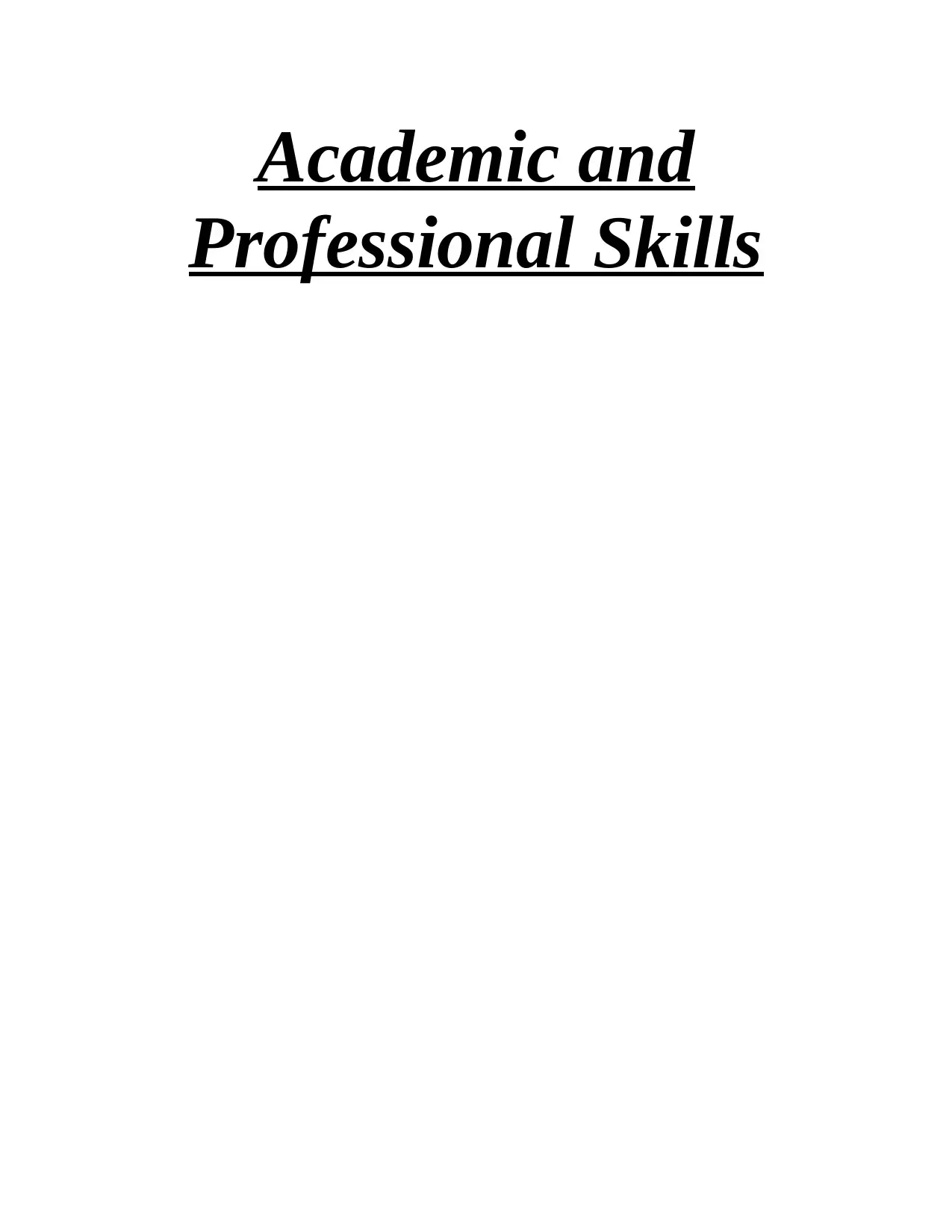
Academic and
Professional Skills
Professional Skills
Paraphrase This Document
Need a fresh take? Get an instant paraphrase of this document with our AI Paraphraser
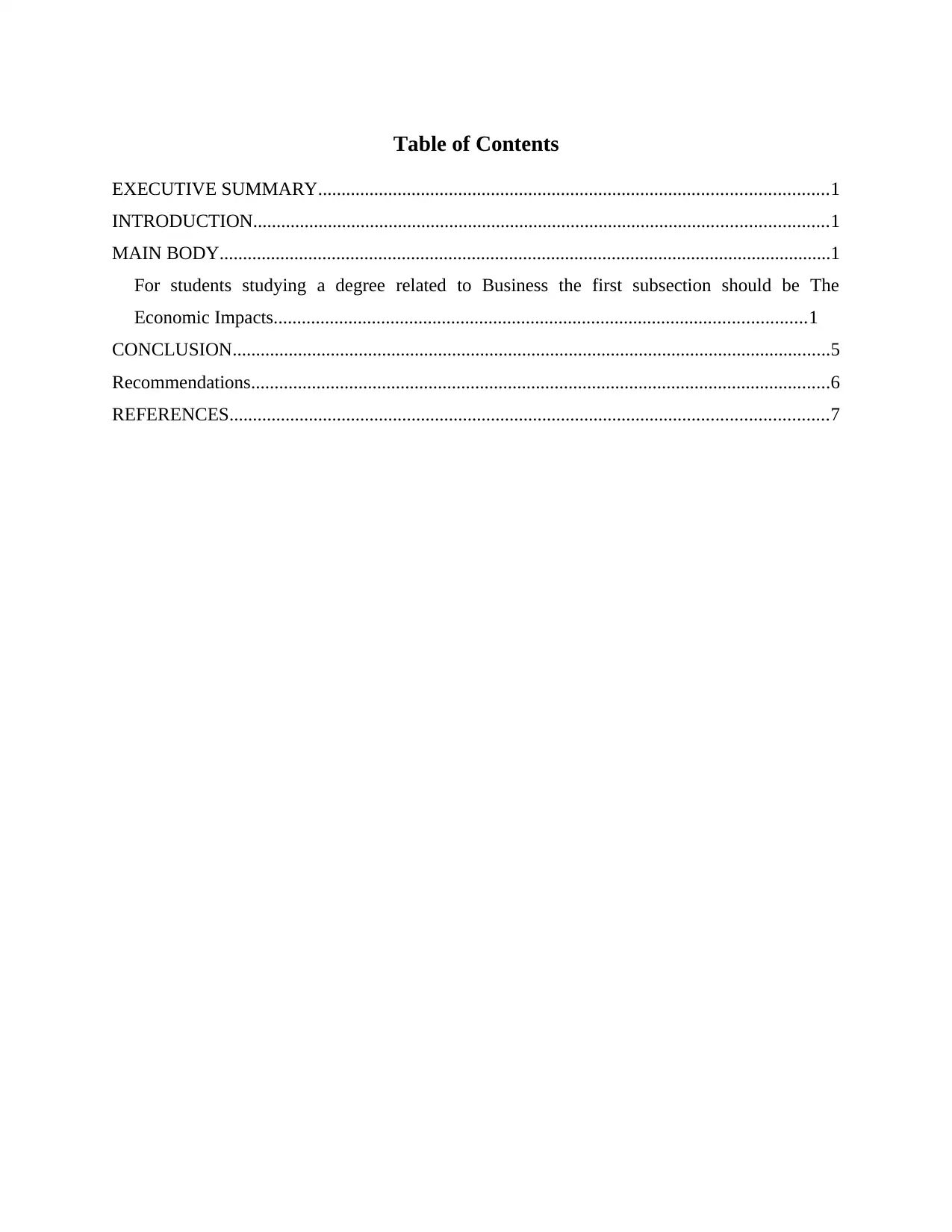
Table of Contents
EXECUTIVE SUMMARY.............................................................................................................1
INTRODUCTION...........................................................................................................................1
MAIN BODY...................................................................................................................................1
For students studying a degree related to Business the first subsection should be The
Economic Impacts..................................................................................................................1
CONCLUSION................................................................................................................................5
Recommendations............................................................................................................................6
REFERENCES................................................................................................................................7
EXECUTIVE SUMMARY.............................................................................................................1
INTRODUCTION...........................................................................................................................1
MAIN BODY...................................................................................................................................1
For students studying a degree related to Business the first subsection should be The
Economic Impacts..................................................................................................................1
CONCLUSION................................................................................................................................5
Recommendations............................................................................................................................6
REFERENCES................................................................................................................................7
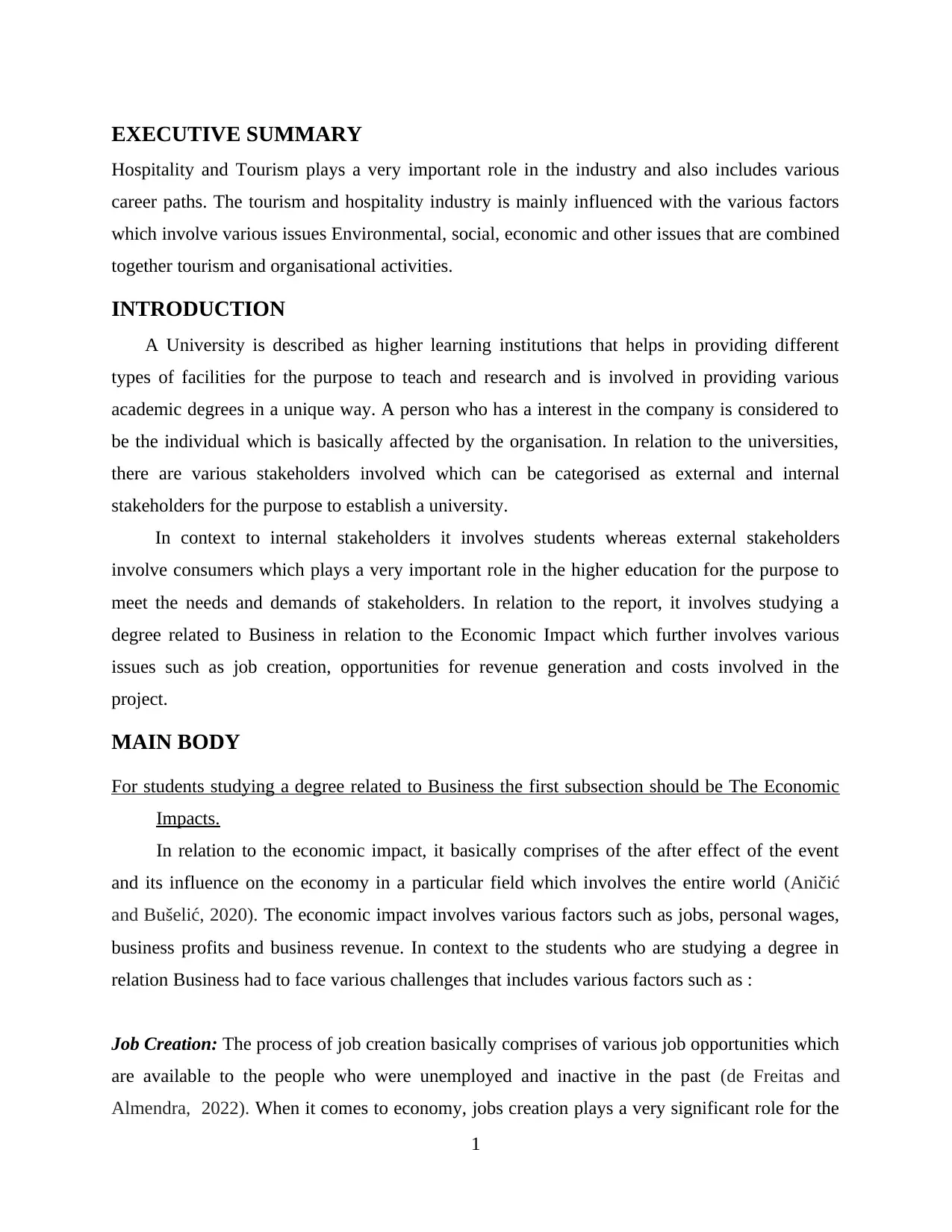
EXECUTIVE SUMMARY
Hospitality and Tourism plays a very important role in the industry and also includes various
career paths. The tourism and hospitality industry is mainly influenced with the various factors
which involve various issues Environmental, social, economic and other issues that are combined
together tourism and organisational activities.
INTRODUCTION
A University is described as higher learning institutions that helps in providing different
types of facilities for the purpose to teach and research and is involved in providing various
academic degrees in a unique way. A person who has a interest in the company is considered to
be the individual which is basically affected by the organisation. In relation to the universities,
there are various stakeholders involved which can be categorised as external and internal
stakeholders for the purpose to establish a university.
In context to internal stakeholders it involves students whereas external stakeholders
involve consumers which plays a very important role in the higher education for the purpose to
meet the needs and demands of stakeholders. In relation to the report, it involves studying a
degree related to Business in relation to the Economic Impact which further involves various
issues such as job creation, opportunities for revenue generation and costs involved in the
project.
MAIN BODY
For students studying a degree related to Business the first subsection should be The Economic
Impacts.
In relation to the economic impact, it basically comprises of the after effect of the event
and its influence on the economy in a particular field which involves the entire world (Aničić
and Bušelić, 2020). The economic impact involves various factors such as jobs, personal wages,
business profits and business revenue. In context to the students who are studying a degree in
relation Business had to face various challenges that includes various factors such as :
Job Creation: The process of job creation basically comprises of various job opportunities which
are available to the people who were unemployed and inactive in the past (de Freitas and
Almendra, 2022). When it comes to economy, jobs creation plays a very significant role for the
1
Hospitality and Tourism plays a very important role in the industry and also includes various
career paths. The tourism and hospitality industry is mainly influenced with the various factors
which involve various issues Environmental, social, economic and other issues that are combined
together tourism and organisational activities.
INTRODUCTION
A University is described as higher learning institutions that helps in providing different
types of facilities for the purpose to teach and research and is involved in providing various
academic degrees in a unique way. A person who has a interest in the company is considered to
be the individual which is basically affected by the organisation. In relation to the universities,
there are various stakeholders involved which can be categorised as external and internal
stakeholders for the purpose to establish a university.
In context to internal stakeholders it involves students whereas external stakeholders
involve consumers which plays a very important role in the higher education for the purpose to
meet the needs and demands of stakeholders. In relation to the report, it involves studying a
degree related to Business in relation to the Economic Impact which further involves various
issues such as job creation, opportunities for revenue generation and costs involved in the
project.
MAIN BODY
For students studying a degree related to Business the first subsection should be The Economic
Impacts.
In relation to the economic impact, it basically comprises of the after effect of the event
and its influence on the economy in a particular field which involves the entire world (Aničić
and Bušelić, 2020). The economic impact involves various factors such as jobs, personal wages,
business profits and business revenue. In context to the students who are studying a degree in
relation Business had to face various challenges that includes various factors such as :
Job Creation: The process of job creation basically comprises of various job opportunities which
are available to the people who were unemployed and inactive in the past (de Freitas and
Almendra, 2022). When it comes to economy, jobs creation plays a very significant role for the
1
⊘ This is a preview!⊘
Do you want full access?
Subscribe today to unlock all pages.

Trusted by 1+ million students worldwide
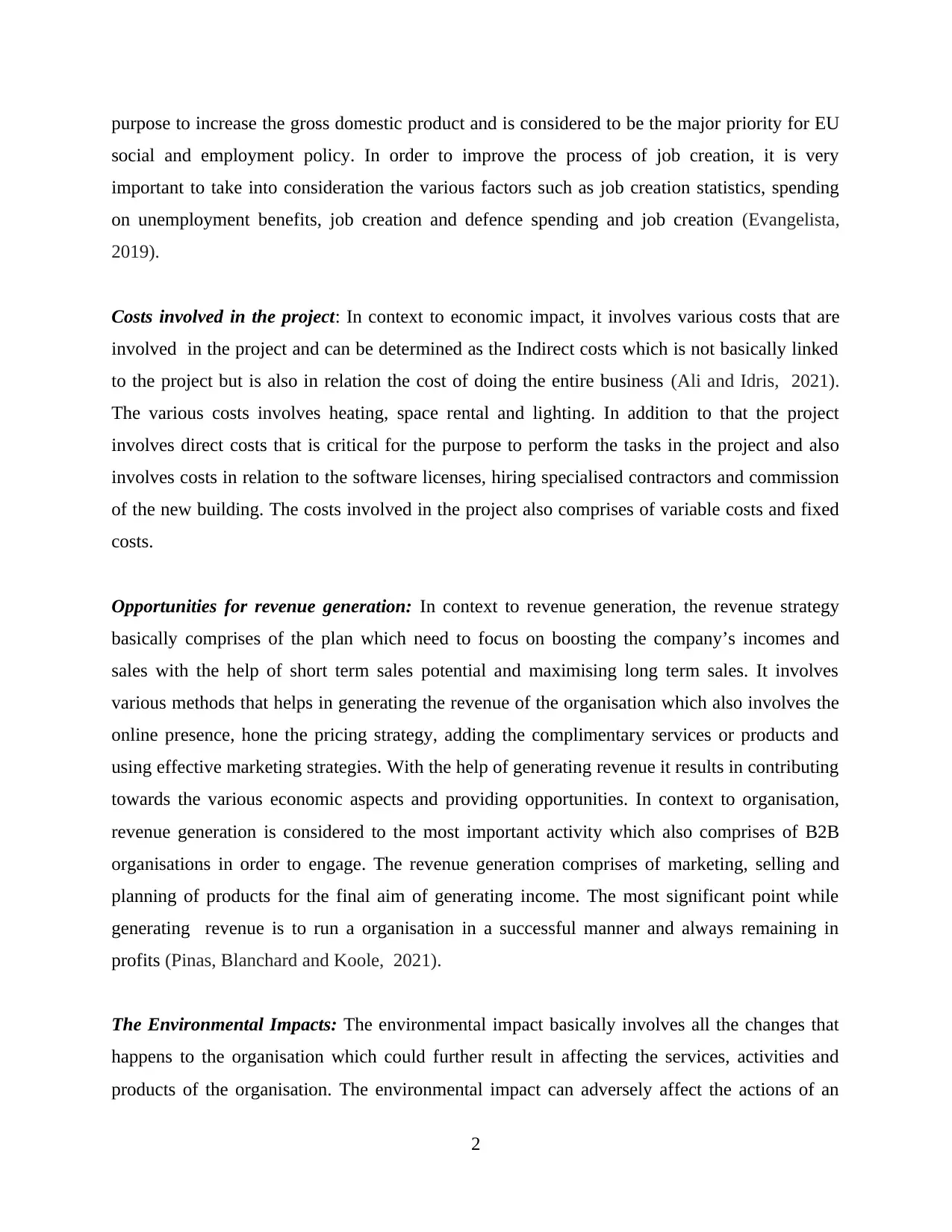
purpose to increase the gross domestic product and is considered to be the major priority for EU
social and employment policy. In order to improve the process of job creation, it is very
important to take into consideration the various factors such as job creation statistics, spending
on unemployment benefits, job creation and defence spending and job creation (Evangelista,
2019).
Costs involved in the project: In context to economic impact, it involves various costs that are
involved in the project and can be determined as the Indirect costs which is not basically linked
to the project but is also in relation the cost of doing the entire business (Ali and Idris, 2021).
The various costs involves heating, space rental and lighting. In addition to that the project
involves direct costs that is critical for the purpose to perform the tasks in the project and also
involves costs in relation to the software licenses, hiring specialised contractors and commission
of the new building. The costs involved in the project also comprises of variable costs and fixed
costs.
Opportunities for revenue generation: In context to revenue generation, the revenue strategy
basically comprises of the plan which need to focus on boosting the company’s incomes and
sales with the help of short term sales potential and maximising long term sales. It involves
various methods that helps in generating the revenue of the organisation which also involves the
online presence, hone the pricing strategy, adding the complimentary services or products and
using effective marketing strategies. With the help of generating revenue it results in contributing
towards the various economic aspects and providing opportunities. In context to organisation,
revenue generation is considered to the most important activity which also comprises of B2B
organisations in order to engage. The revenue generation comprises of marketing, selling and
planning of products for the final aim of generating income. The most significant point while
generating revenue is to run a organisation in a successful manner and always remaining in
profits (Pinas, Blanchard and Koole, 2021).
The Environmental Impacts: The environmental impact basically involves all the changes that
happens to the organisation which could further result in affecting the services, activities and
products of the organisation. The environmental impact can adversely affect the actions of an
2
social and employment policy. In order to improve the process of job creation, it is very
important to take into consideration the various factors such as job creation statistics, spending
on unemployment benefits, job creation and defence spending and job creation (Evangelista,
2019).
Costs involved in the project: In context to economic impact, it involves various costs that are
involved in the project and can be determined as the Indirect costs which is not basically linked
to the project but is also in relation the cost of doing the entire business (Ali and Idris, 2021).
The various costs involves heating, space rental and lighting. In addition to that the project
involves direct costs that is critical for the purpose to perform the tasks in the project and also
involves costs in relation to the software licenses, hiring specialised contractors and commission
of the new building. The costs involved in the project also comprises of variable costs and fixed
costs.
Opportunities for revenue generation: In context to revenue generation, the revenue strategy
basically comprises of the plan which need to focus on boosting the company’s incomes and
sales with the help of short term sales potential and maximising long term sales. It involves
various methods that helps in generating the revenue of the organisation which also involves the
online presence, hone the pricing strategy, adding the complimentary services or products and
using effective marketing strategies. With the help of generating revenue it results in contributing
towards the various economic aspects and providing opportunities. In context to organisation,
revenue generation is considered to the most important activity which also comprises of B2B
organisations in order to engage. The revenue generation comprises of marketing, selling and
planning of products for the final aim of generating income. The most significant point while
generating revenue is to run a organisation in a successful manner and always remaining in
profits (Pinas, Blanchard and Koole, 2021).
The Environmental Impacts: The environmental impact basically involves all the changes that
happens to the organisation which could further result in affecting the services, activities and
products of the organisation. The environmental impact can adversely affect the actions of an
2
Paraphrase This Document
Need a fresh take? Get an instant paraphrase of this document with our AI Paraphraser
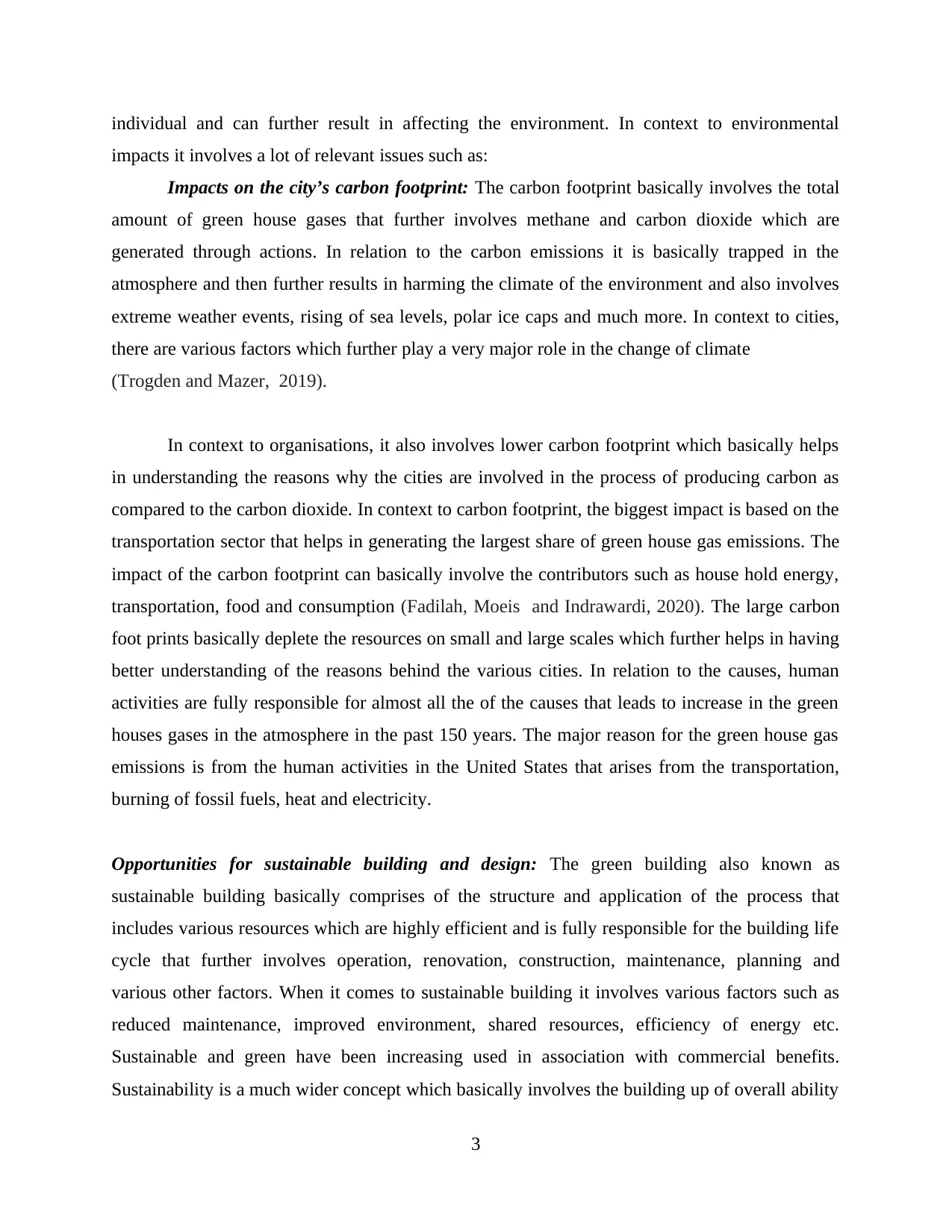
individual and can further result in affecting the environment. In context to environmental
impacts it involves a lot of relevant issues such as:
Impacts on the city’s carbon footprint: The carbon footprint basically involves the total
amount of green house gases that further involves methane and carbon dioxide which are
generated through actions. In relation to the carbon emissions it is basically trapped in the
atmosphere and then further results in harming the climate of the environment and also involves
extreme weather events, rising of sea levels, polar ice caps and much more. In context to cities,
there are various factors which further play a very major role in the change of climate
(Trogden and Mazer, 2019).
In context to organisations, it also involves lower carbon footprint which basically helps
in understanding the reasons why the cities are involved in the process of producing carbon as
compared to the carbon dioxide. In context to carbon footprint, the biggest impact is based on the
transportation sector that helps in generating the largest share of green house gas emissions. The
impact of the carbon footprint can basically involve the contributors such as house hold energy,
transportation, food and consumption (Fadilah, Moeis and Indrawardi, 2020). The large carbon
foot prints basically deplete the resources on small and large scales which further helps in having
better understanding of the reasons behind the various cities. In relation to the causes, human
activities are fully responsible for almost all the of the causes that leads to increase in the green
houses gases in the atmosphere in the past 150 years. The major reason for the green house gas
emissions is from the human activities in the United States that arises from the transportation,
burning of fossil fuels, heat and electricity.
Opportunities for sustainable building and design: The green building also known as
sustainable building basically comprises of the structure and application of the process that
includes various resources which are highly efficient and is fully responsible for the building life
cycle that further involves operation, renovation, construction, maintenance, planning and
various other factors. When it comes to sustainable building it involves various factors such as
reduced maintenance, improved environment, shared resources, efficiency of energy etc.
Sustainable and green have been increasing used in association with commercial benefits.
Sustainability is a much wider concept which basically involves the building up of overall ability
3
impacts it involves a lot of relevant issues such as:
Impacts on the city’s carbon footprint: The carbon footprint basically involves the total
amount of green house gases that further involves methane and carbon dioxide which are
generated through actions. In relation to the carbon emissions it is basically trapped in the
atmosphere and then further results in harming the climate of the environment and also involves
extreme weather events, rising of sea levels, polar ice caps and much more. In context to cities,
there are various factors which further play a very major role in the change of climate
(Trogden and Mazer, 2019).
In context to organisations, it also involves lower carbon footprint which basically helps
in understanding the reasons why the cities are involved in the process of producing carbon as
compared to the carbon dioxide. In context to carbon footprint, the biggest impact is based on the
transportation sector that helps in generating the largest share of green house gas emissions. The
impact of the carbon footprint can basically involve the contributors such as house hold energy,
transportation, food and consumption (Fadilah, Moeis and Indrawardi, 2020). The large carbon
foot prints basically deplete the resources on small and large scales which further helps in having
better understanding of the reasons behind the various cities. In relation to the causes, human
activities are fully responsible for almost all the of the causes that leads to increase in the green
houses gases in the atmosphere in the past 150 years. The major reason for the green house gas
emissions is from the human activities in the United States that arises from the transportation,
burning of fossil fuels, heat and electricity.
Opportunities for sustainable building and design: The green building also known as
sustainable building basically comprises of the structure and application of the process that
includes various resources which are highly efficient and is fully responsible for the building life
cycle that further involves operation, renovation, construction, maintenance, planning and
various other factors. When it comes to sustainable building it involves various factors such as
reduced maintenance, improved environment, shared resources, efficiency of energy etc.
Sustainable and green have been increasing used in association with commercial benefits.
Sustainability is a much wider concept which basically involves the building up of overall ability
3
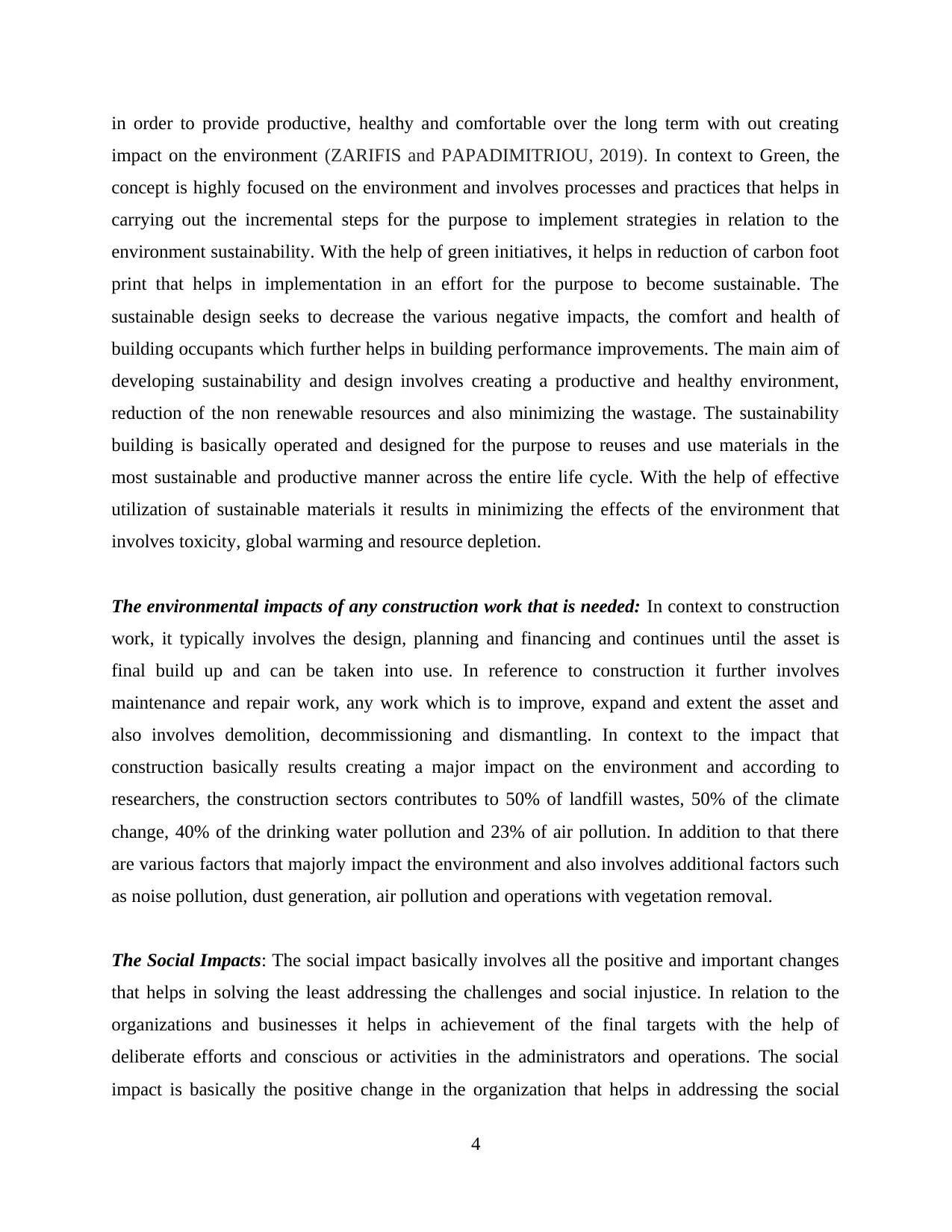
in order to provide productive, healthy and comfortable over the long term with out creating
impact on the environment (ZARIFIS and PAPADIMITRIOU, 2019). In context to Green, the
concept is highly focused on the environment and involves processes and practices that helps in
carrying out the incremental steps for the purpose to implement strategies in relation to the
environment sustainability. With the help of green initiatives, it helps in reduction of carbon foot
print that helps in implementation in an effort for the purpose to become sustainable. The
sustainable design seeks to decrease the various negative impacts, the comfort and health of
building occupants which further helps in building performance improvements. The main aim of
developing sustainability and design involves creating a productive and healthy environment,
reduction of the non renewable resources and also minimizing the wastage. The sustainability
building is basically operated and designed for the purpose to reuses and use materials in the
most sustainable and productive manner across the entire life cycle. With the help of effective
utilization of sustainable materials it results in minimizing the effects of the environment that
involves toxicity, global warming and resource depletion.
The environmental impacts of any construction work that is needed: In context to construction
work, it typically involves the design, planning and financing and continues until the asset is
final build up and can be taken into use. In reference to construction it further involves
maintenance and repair work, any work which is to improve, expand and extent the asset and
also involves demolition, decommissioning and dismantling. In context to the impact that
construction basically results creating a major impact on the environment and according to
researchers, the construction sectors contributes to 50% of landfill wastes, 50% of the climate
change, 40% of the drinking water pollution and 23% of air pollution. In addition to that there
are various factors that majorly impact the environment and also involves additional factors such
as noise pollution, dust generation, air pollution and operations with vegetation removal.
The Social Impacts: The social impact basically involves all the positive and important changes
that helps in solving the least addressing the challenges and social injustice. In relation to the
organizations and businesses it helps in achievement of the final targets with the help of
deliberate efforts and conscious or activities in the administrators and operations. The social
impact is basically the positive change in the organization that helps in addressing the social
4
impact on the environment (ZARIFIS and PAPADIMITRIOU, 2019). In context to Green, the
concept is highly focused on the environment and involves processes and practices that helps in
carrying out the incremental steps for the purpose to implement strategies in relation to the
environment sustainability. With the help of green initiatives, it helps in reduction of carbon foot
print that helps in implementation in an effort for the purpose to become sustainable. The
sustainable design seeks to decrease the various negative impacts, the comfort and health of
building occupants which further helps in building performance improvements. The main aim of
developing sustainability and design involves creating a productive and healthy environment,
reduction of the non renewable resources and also minimizing the wastage. The sustainability
building is basically operated and designed for the purpose to reuses and use materials in the
most sustainable and productive manner across the entire life cycle. With the help of effective
utilization of sustainable materials it results in minimizing the effects of the environment that
involves toxicity, global warming and resource depletion.
The environmental impacts of any construction work that is needed: In context to construction
work, it typically involves the design, planning and financing and continues until the asset is
final build up and can be taken into use. In reference to construction it further involves
maintenance and repair work, any work which is to improve, expand and extent the asset and
also involves demolition, decommissioning and dismantling. In context to the impact that
construction basically results creating a major impact on the environment and according to
researchers, the construction sectors contributes to 50% of landfill wastes, 50% of the climate
change, 40% of the drinking water pollution and 23% of air pollution. In addition to that there
are various factors that majorly impact the environment and also involves additional factors such
as noise pollution, dust generation, air pollution and operations with vegetation removal.
The Social Impacts: The social impact basically involves all the positive and important changes
that helps in solving the least addressing the challenges and social injustice. In relation to the
organizations and businesses it helps in achievement of the final targets with the help of
deliberate efforts and conscious or activities in the administrators and operations. The social
impact is basically the positive change in the organization that helps in addressing the social
4
⊘ This is a preview!⊘
Do you want full access?
Subscribe today to unlock all pages.

Trusted by 1+ million students worldwide
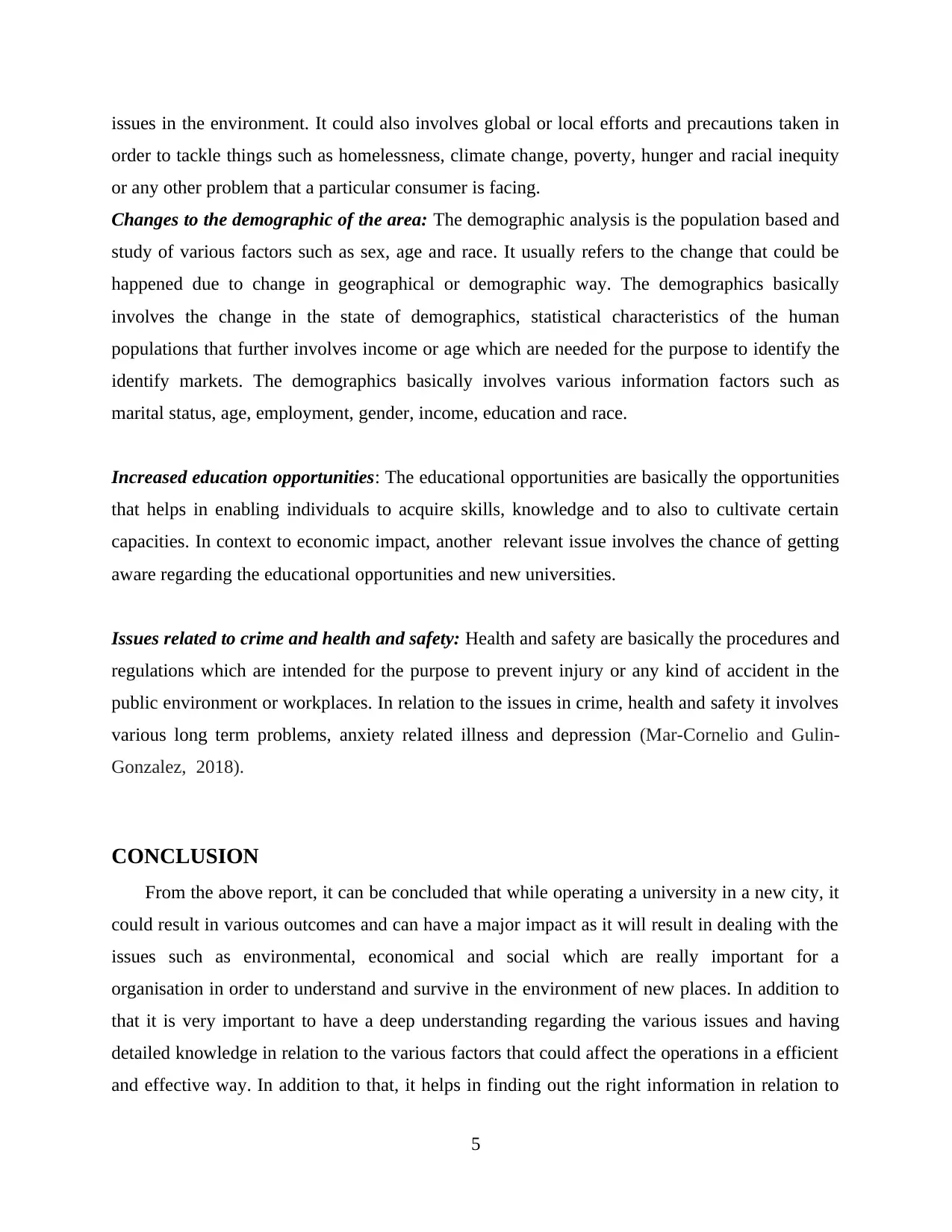
issues in the environment. It could also involves global or local efforts and precautions taken in
order to tackle things such as homelessness, climate change, poverty, hunger and racial inequity
or any other problem that a particular consumer is facing.
Changes to the demographic of the area: The demographic analysis is the population based and
study of various factors such as sex, age and race. It usually refers to the change that could be
happened due to change in geographical or demographic way. The demographics basically
involves the change in the state of demographics, statistical characteristics of the human
populations that further involves income or age which are needed for the purpose to identify the
identify markets. The demographics basically involves various information factors such as
marital status, age, employment, gender, income, education and race.
Increased education opportunities: The educational opportunities are basically the opportunities
that helps in enabling individuals to acquire skills, knowledge and to also to cultivate certain
capacities. In context to economic impact, another relevant issue involves the chance of getting
aware regarding the educational opportunities and new universities.
Issues related to crime and health and safety: Health and safety are basically the procedures and
regulations which are intended for the purpose to prevent injury or any kind of accident in the
public environment or workplaces. In relation to the issues in crime, health and safety it involves
various long term problems, anxiety related illness and depression (Mar-Cornelio and Gulin-
Gonzalez, 2018).
CONCLUSION
From the above report, it can be concluded that while operating a university in a new city, it
could result in various outcomes and can have a major impact as it will result in dealing with the
issues such as environmental, economical and social which are really important for a
organisation in order to understand and survive in the environment of new places. In addition to
that it is very important to have a deep understanding regarding the various issues and having
detailed knowledge in relation to the various factors that could affect the operations in a efficient
and effective way. In addition to that, it helps in finding out the right information in relation to
5
order to tackle things such as homelessness, climate change, poverty, hunger and racial inequity
or any other problem that a particular consumer is facing.
Changes to the demographic of the area: The demographic analysis is the population based and
study of various factors such as sex, age and race. It usually refers to the change that could be
happened due to change in geographical or demographic way. The demographics basically
involves the change in the state of demographics, statistical characteristics of the human
populations that further involves income or age which are needed for the purpose to identify the
identify markets. The demographics basically involves various information factors such as
marital status, age, employment, gender, income, education and race.
Increased education opportunities: The educational opportunities are basically the opportunities
that helps in enabling individuals to acquire skills, knowledge and to also to cultivate certain
capacities. In context to economic impact, another relevant issue involves the chance of getting
aware regarding the educational opportunities and new universities.
Issues related to crime and health and safety: Health and safety are basically the procedures and
regulations which are intended for the purpose to prevent injury or any kind of accident in the
public environment or workplaces. In relation to the issues in crime, health and safety it involves
various long term problems, anxiety related illness and depression (Mar-Cornelio and Gulin-
Gonzalez, 2018).
CONCLUSION
From the above report, it can be concluded that while operating a university in a new city, it
could result in various outcomes and can have a major impact as it will result in dealing with the
issues such as environmental, economical and social which are really important for a
organisation in order to understand and survive in the environment of new places. In addition to
that it is very important to have a deep understanding regarding the various issues and having
detailed knowledge in relation to the various factors that could affect the operations in a efficient
and effective way. In addition to that, it helps in finding out the right information in relation to
5
Paraphrase This Document
Need a fresh take? Get an instant paraphrase of this document with our AI Paraphraser
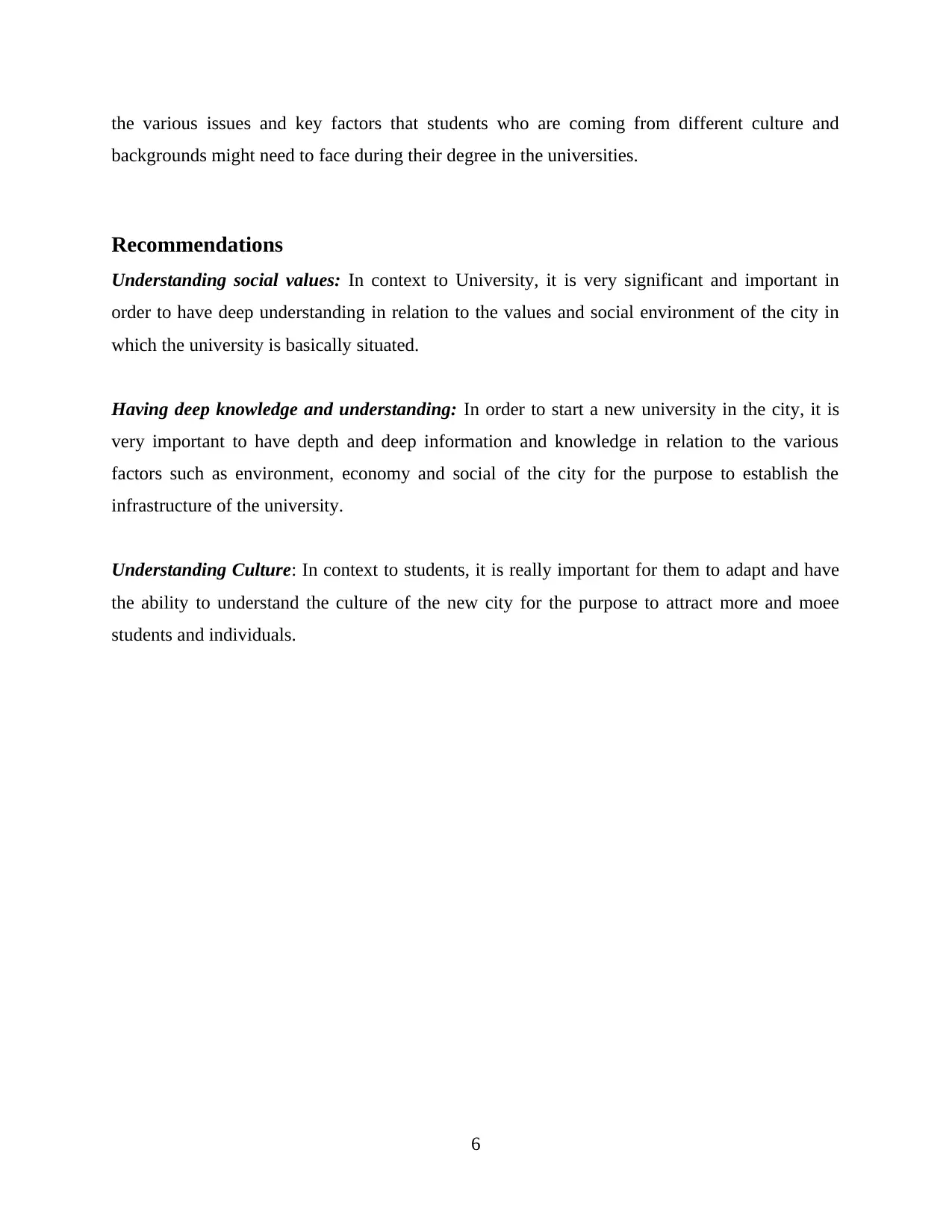
the various issues and key factors that students who are coming from different culture and
backgrounds might need to face during their degree in the universities.
Recommendations
Understanding social values: In context to University, it is very significant and important in
order to have deep understanding in relation to the values and social environment of the city in
which the university is basically situated.
Having deep knowledge and understanding: In order to start a new university in the city, it is
very important to have depth and deep information and knowledge in relation to the various
factors such as environment, economy and social of the city for the purpose to establish the
infrastructure of the university.
Understanding Culture: In context to students, it is really important for them to adapt and have
the ability to understand the culture of the new city for the purpose to attract more and moee
students and individuals.
6
backgrounds might need to face during their degree in the universities.
Recommendations
Understanding social values: In context to University, it is very significant and important in
order to have deep understanding in relation to the values and social environment of the city in
which the university is basically situated.
Having deep knowledge and understanding: In order to start a new university in the city, it is
very important to have depth and deep information and knowledge in relation to the various
factors such as environment, economy and social of the city for the purpose to establish the
infrastructure of the university.
Understanding Culture: In context to students, it is really important for them to adapt and have
the ability to understand the culture of the new city for the purpose to attract more and moee
students and individuals.
6
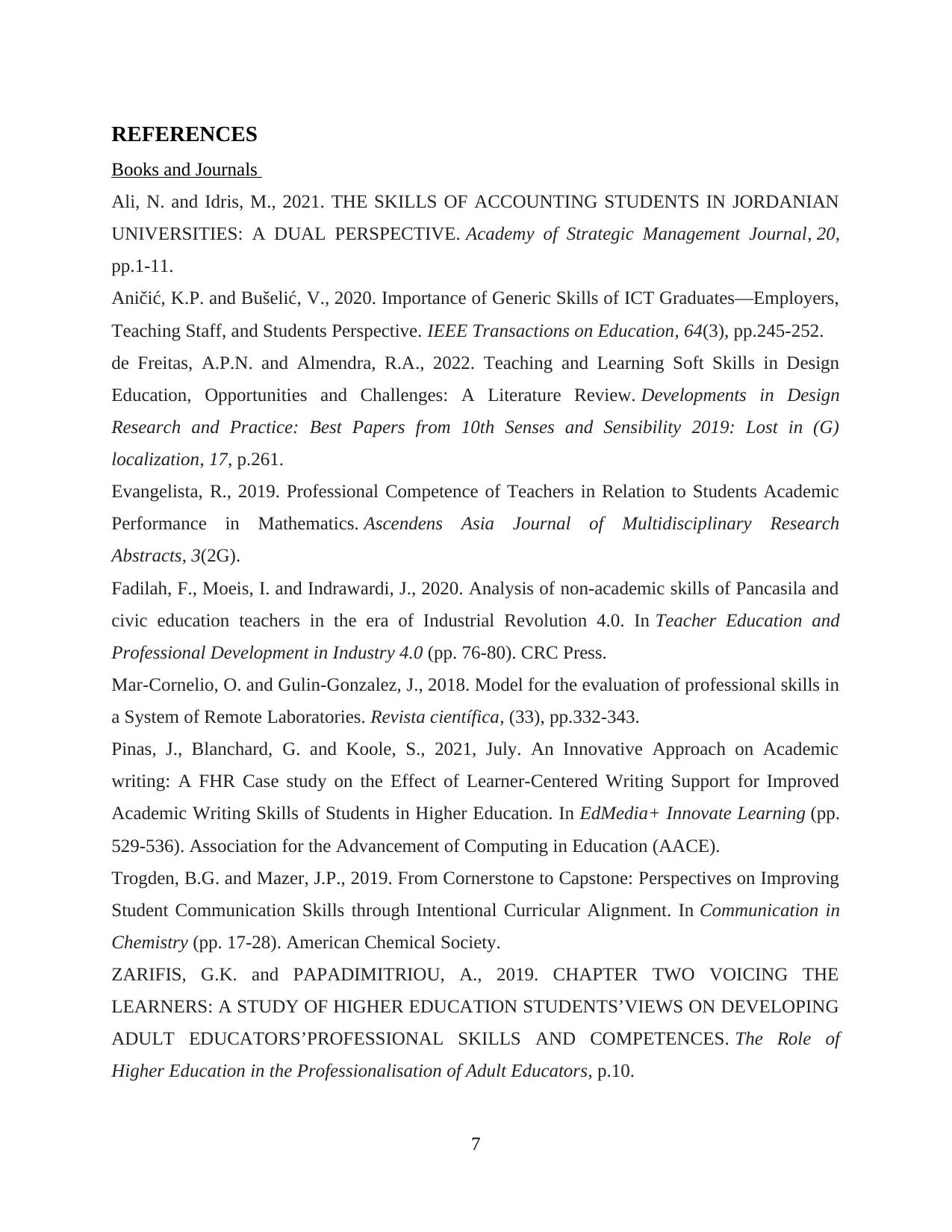
REFERENCES
Books and Journals
Ali, N. and Idris, M., 2021. THE SKILLS OF ACCOUNTING STUDENTS IN JORDANIAN
UNIVERSITIES: A DUAL PERSPECTIVE. Academy of Strategic Management Journal, 20,
pp.1-11.
Aničić, K.P. and Bušelić, V., 2020. Importance of Generic Skills of ICT Graduates—Employers,
Teaching Staff, and Students Perspective. IEEE Transactions on Education, 64(3), pp.245-252.
de Freitas, A.P.N. and Almendra, R.A., 2022. Teaching and Learning Soft Skills in Design
Education, Opportunities and Challenges: A Literature Review. Developments in Design
Research and Practice: Best Papers from 10th Senses and Sensibility 2019: Lost in (G)
localization, 17, p.261.
Evangelista, R., 2019. Professional Competence of Teachers in Relation to Students Academic
Performance in Mathematics. Ascendens Asia Journal of Multidisciplinary Research
Abstracts, 3(2G).
Fadilah, F., Moeis, I. and Indrawardi, J., 2020. Analysis of non-academic skills of Pancasila and
civic education teachers in the era of Industrial Revolution 4.0. In Teacher Education and
Professional Development in Industry 4.0 (pp. 76-80). CRC Press.
Mar-Cornelio, O. and Gulin-Gonzalez, J., 2018. Model for the evaluation of professional skills in
a System of Remote Laboratories. Revista científica, (33), pp.332-343.
Pinas, J., Blanchard, G. and Koole, S., 2021, July. An Innovative Approach on Academic
writing: A FHR Case study on the Effect of Learner-Centered Writing Support for Improved
Academic Writing Skills of Students in Higher Education. In EdMedia+ Innovate Learning (pp.
529-536). Association for the Advancement of Computing in Education (AACE).
Trogden, B.G. and Mazer, J.P., 2019. From Cornerstone to Capstone: Perspectives on Improving
Student Communication Skills through Intentional Curricular Alignment. In Communication in
Chemistry (pp. 17-28). American Chemical Society.
ZARIFIS, G.K. and PAPADIMITRIOU, A., 2019. CHAPTER TWO VOICING THE
LEARNERS: A STUDY OF HIGHER EDUCATION STUDENTS’VIEWS ON DEVELOPING
ADULT EDUCATORS’PROFESSIONAL SKILLS AND COMPETENCES. The Role of
Higher Education in the Professionalisation of Adult Educators, p.10.
7
Books and Journals
Ali, N. and Idris, M., 2021. THE SKILLS OF ACCOUNTING STUDENTS IN JORDANIAN
UNIVERSITIES: A DUAL PERSPECTIVE. Academy of Strategic Management Journal, 20,
pp.1-11.
Aničić, K.P. and Bušelić, V., 2020. Importance of Generic Skills of ICT Graduates—Employers,
Teaching Staff, and Students Perspective. IEEE Transactions on Education, 64(3), pp.245-252.
de Freitas, A.P.N. and Almendra, R.A., 2022. Teaching and Learning Soft Skills in Design
Education, Opportunities and Challenges: A Literature Review. Developments in Design
Research and Practice: Best Papers from 10th Senses and Sensibility 2019: Lost in (G)
localization, 17, p.261.
Evangelista, R., 2019. Professional Competence of Teachers in Relation to Students Academic
Performance in Mathematics. Ascendens Asia Journal of Multidisciplinary Research
Abstracts, 3(2G).
Fadilah, F., Moeis, I. and Indrawardi, J., 2020. Analysis of non-academic skills of Pancasila and
civic education teachers in the era of Industrial Revolution 4.0. In Teacher Education and
Professional Development in Industry 4.0 (pp. 76-80). CRC Press.
Mar-Cornelio, O. and Gulin-Gonzalez, J., 2018. Model for the evaluation of professional skills in
a System of Remote Laboratories. Revista científica, (33), pp.332-343.
Pinas, J., Blanchard, G. and Koole, S., 2021, July. An Innovative Approach on Academic
writing: A FHR Case study on the Effect of Learner-Centered Writing Support for Improved
Academic Writing Skills of Students in Higher Education. In EdMedia+ Innovate Learning (pp.
529-536). Association for the Advancement of Computing in Education (AACE).
Trogden, B.G. and Mazer, J.P., 2019. From Cornerstone to Capstone: Perspectives on Improving
Student Communication Skills through Intentional Curricular Alignment. In Communication in
Chemistry (pp. 17-28). American Chemical Society.
ZARIFIS, G.K. and PAPADIMITRIOU, A., 2019. CHAPTER TWO VOICING THE
LEARNERS: A STUDY OF HIGHER EDUCATION STUDENTS’VIEWS ON DEVELOPING
ADULT EDUCATORS’PROFESSIONAL SKILLS AND COMPETENCES. The Role of
Higher Education in the Professionalisation of Adult Educators, p.10.
7
⊘ This is a preview!⊘
Do you want full access?
Subscribe today to unlock all pages.

Trusted by 1+ million students worldwide

8
1 out of 10
Related Documents
Your All-in-One AI-Powered Toolkit for Academic Success.
+13062052269
info@desklib.com
Available 24*7 on WhatsApp / Email
![[object Object]](/_next/static/media/star-bottom.7253800d.svg)
Unlock your academic potential
Copyright © 2020–2025 A2Z Services. All Rights Reserved. Developed and managed by ZUCOL.



